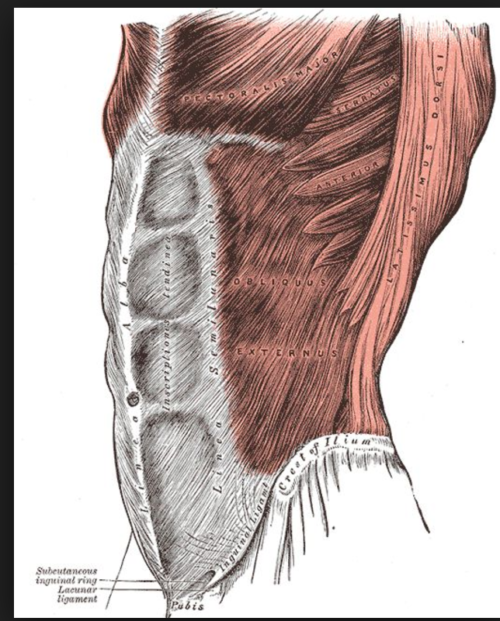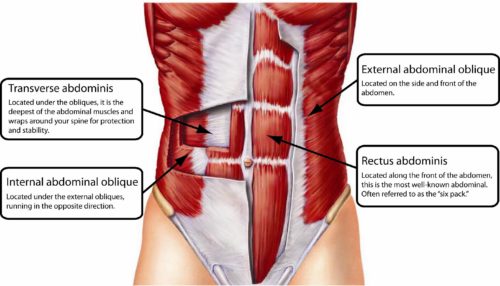
Most people have a general sense that having a strong core is good for your health. Having a strong core is a great support for the lower back and helps us move in an integrated way, rather than just flailing around. We see how important this is in movement activities like yoga but even in other things like running, where, with no core awareness, your feet flop and pound the pavement and your legs move with no sense of connection to the rest of your body.
I recently had a abdominal surgery to remove a cyst and let me tell you; once they make a few incisions in your abdomen, you get a newfound appreciation for your core. It gave me a reason to refer back to core anatomy and as such, I came across my two nemesis muscles, the internal and external obliques.

I call them my “nemesis muscles” because I have always had a hard time remembering in which direction each one lies and their actions. I know that they are responsible for twisting and rotation of the trunk as well as being core stabilizers but I wanted to be clearer about their individual roles.
It’s always a bit challenging looking at anatomy pictures to get a good sense of the direction of the muscle fibers in an individual muscle. Also, there are sometimes differences from text to text and article to article. Sometimes it can be helpful to look at the origin and insertion of the muscle to get a sense of the direction of the fibers. Also, because these two muscles are fairly broad in shape, when compared to a muscle like the biceps which is more of a straight line, their origins and insertions are pretty big. So, for today’s conversation, I’m going to try to boil it down to some general concepts.
External Oblique: The abdominal muscles are in layers and the external oblique is the outermost layer. I remember this because of it’s name: external, meaning, most superficial and on the outer layer before the fascia and skin. It generally runs from your ribs to the linea alba, which is a line of tough, fibrous tissue that runs down the middle of your abdomen. So, it runs from the “top DOWN” because it goes from the ribs to this midline attachment point. If you put your hand on your belly with the heel of your hand right under your chest and point your fingers towards your belly button, that’s generally how the muscle runs. Remember, there is one on each side of your belly.
When it contracts, it bends you to the side. This is called “lateral flexion.” Now, because there is one on each side, we have to further describe that when the one on the right side contracts, it bends you to that side. When the one on the left contracts, it bends you to that side.
It also helps you twist. When the one on the right contracts, it twists you to the LEFT. When the one on the left contracts, it twists you the RIGHT.
Internal Oblique: This muscle lies under the external oblique. This muscle starts on your iliac crest    (the top edge of your pelvis ) and inserts on the rectus sheath, which is basically the “container” or sheath, that holds your rectus abdominus muscle that runs up the center of your body. So, if you place your hand on your belly, palm down, and rest the heel of your hand on your hip (you’ll feel that ridge of your iliac crest) and then rest your fingers along the ridge in the middle of your belly (where your rectus abdominus is), that’s generally where this muscle lies.
Now, this muscle is also a pair, so there’s one on each side. When it contracts, it rotates you to the same side as the muscle that is contracting. So that means if your internal oblique on the right contracts, it turns you to the right and if the internal oblique on the left contracts, it turns you to the left. It also is a lateral flexor of the spine or a side bending muscle and bends you to the same side as the muscle that is contracting.
As with all things in anatomy, the more you apply it in teaching, the better it sticks in your brain. Keep re-reading and applying it and eventually the information will come more naturally.
If you enjoy learning about anatomy, check out my online courses on anatomy. Reasonably priced, easy to complete on your own schedule AND you get CEU credits for Yoga Alliance, they each focus on different aspects of anatomy:
Bare Bones Yoga Online Anatomy Courses
If you’re looking for a short, interactive (read: video) way to learn anatomy, my 60 minute class on Vimeo is filled with anatomical tips. You can get it for just $10 here.Â
Thank you for reading!
